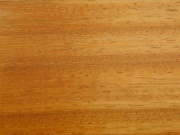Difference between revisions of "Iroko"
Jump to navigation
Jump to search
(username removed) |
|||
| (3 intermediate revisions by 2 users not shown) | |||
| Line 6: | Line 6: | ||
== Synonyms and Related Terms == | == Synonyms and Related Terms == | ||
| − | ''Chlorophor excelsa''; mvule; African teak; iroko (Fr.); | + | ''Chlorophor excelsa''; mvule; African teak; iroko (Fr.); câmbala (Port.) |
| − | + | == Risks == | |
| − | |||
| − | |||
| − | |||
| − | |||
| − | == | + | * Susceptible to wood borers. |
| + | * Skin contact may cause irritation. | ||
| + | ==Physical and Chemical Properties== | ||
| + | * Heartwood is yellow to golden with dolor darkening over time; sapwood is a clearly paler yellow | ||
| + | * Grain is interlocked with open pores and a medium to coarse texture | ||
| + | * Wood is durable and sometimes used as a substitute for teak | ||
| + | * Density = 41 ppcf | ||
| + | ==Working Properties== | ||
| + | * Generally easy to work, with the exception of its interlocked grain, which may cause some tearout during surfacing operations | ||
| + | * Deposits of calcium carbonate are sometimes present, which can have a significant dulling effect on cutters | ||
| + | * Glues and finishes well. | ||
| + | ==Resources and Citations== | ||
| + | * The Wood Database: [https://www.wood-database.com/iroko/ Iroko] | ||
| − | + | * F. H. Titmuss, ''Commercial Timbers of the World'', The Technical Press Ltd., London, 1965 Comment: 41 ppcf | |
| − | + | * Michael McCann, ''Artist Beware'', Watson-Guptill Publications, New York City, 1979 | |
| − | |||
| − | |||
| − | |||
| − | * | ||
| − | |||
| − | |||
* ''CRC Handbook of Chemistry and Physics'', Robert Weast (ed.), CRC Press, Boca Raton, Florida, v. 61, 1980 Comment: density=61 ppcf (0.98 g/cm3) | * ''CRC Handbook of Chemistry and Physics'', Robert Weast (ed.), CRC Press, Boca Raton, Florida, v. 61, 1980 Comment: density=61 ppcf (0.98 g/cm3) | ||
Latest revision as of 10:16, 21 September 2022
Description
A wood produced from the Chlorophor excelsa tree native to Africa. Iroko is a medium weight wood with an open-grain texture. The color is a brown with yellow streaks. Iroko has been used for structures, ship building, cabinets, and furniture.
Synonyms and Related Terms
Chlorophor excelsa; mvule; African teak; iroko (Fr.); câmbala (Port.)
Risks
- Susceptible to wood borers.
- Skin contact may cause irritation.
Physical and Chemical Properties
- Heartwood is yellow to golden with dolor darkening over time; sapwood is a clearly paler yellow
- Grain is interlocked with open pores and a medium to coarse texture
- Wood is durable and sometimes used as a substitute for teak
- Density = 41 ppcf
Working Properties
- Generally easy to work, with the exception of its interlocked grain, which may cause some tearout during surfacing operations
- Deposits of calcium carbonate are sometimes present, which can have a significant dulling effect on cutters
- Glues and finishes well.
Resources and Citations
- The Wood Database: Iroko
- F. H. Titmuss, Commercial Timbers of the World, The Technical Press Ltd., London, 1965 Comment: 41 ppcf
- Michael McCann, Artist Beware, Watson-Guptill Publications, New York City, 1979
- CRC Handbook of Chemistry and Physics, Robert Weast (ed.), CRC Press, Boca Raton, Florida, v. 61, 1980 Comment: density=61 ppcf (0.98 g/cm3)
